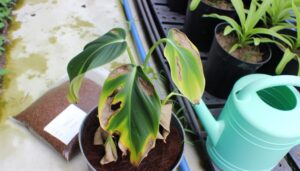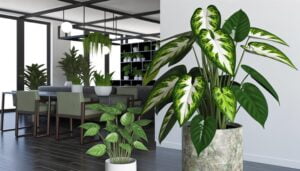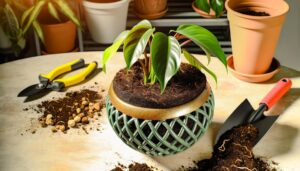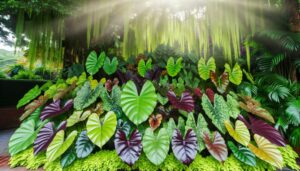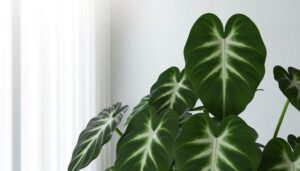Why Is My Philodendron Birkin Leggy?
Leggy growth in Philodendron Birkin is often attributed to insufficient light, leading to etiolation, where stems elongate in response to low light conditions. Overwatering can induce root rot and subsequent fungal issues, while inadequate humidity, below 40%, inhibits proper nutrient uptake.
Nutrient deficiencies, particularly in nitrogen, phosphorus, potassium, and magnesium, also contribute to stunted growth and chlorosis. Incorrect pot size restricts root development, exacerbating weak stems.
Implementing proper pruning techniques during the growing season is essential to mitigate leggy growth. By addressing these factors, the health and appearance of your Philodendron Birkin can be notably improved.
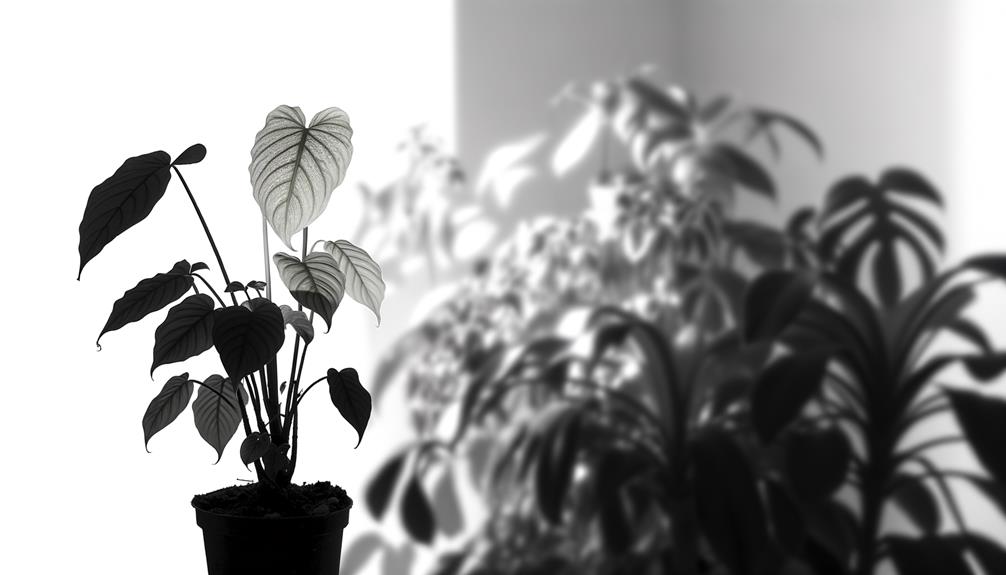
Key Takeaways
- Insufficient light leads to etiolation, causing stems to elongate and internodal spacing to increase.
- Overwatering results in root rot and fungal infections, hindering healthy growth.
- Low humidity levels reduce nutrient uptake and lead to stunted, leggy growth.
- Nutrient deficiencies, particularly in nitrogen, phosphorus, potassium, and magnesium, impact overall plant health and growth.
- Incorrect pot size restricts root development, causing weak stems and stunted growth.
Insufficient Light
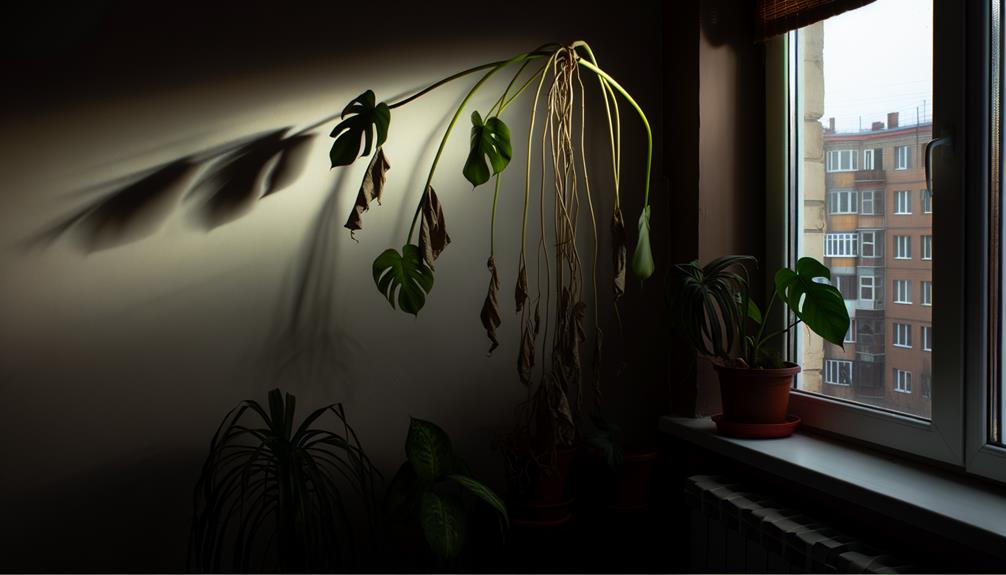
Insufficient light is a primary factor contributing to the legginess observed in Philodendron Birkin, as these plants require adequate light intensity to maintain compact and robust growth. Reduced light exposure induces etiolation, where stems elongate excessively in a bid to reach a light source.
This phenomenon is substantiated by the photomorphogenic response, whereby plants modulate growth patterns under suboptimal light conditions. Empirical studies have demonstrated that Philodendron Birkin, when subjected to low light levels, exhibits increased internodal spacing and diminished chlorophyll concentration, detracting from its aesthetic appeal.
To mitigate these effects, it is recommended to place the plant in an environment with bright, indirect sunlight, mimicking its natural habitat of understory tropical forests, thereby optimizing its morphological development.
Overwatering Issues
Overwatering is a crucial issue that can severely compromise the health of Philodendron Birkin, leading to root rot, fungal infections, and other physiological disorders that impede its growth and well-being.
Excessive moisture in the soil creates an anaerobic environment, favoring pathogenic fungi such as Pythium and Phytophthora, which invade and deteriorate root tissues. This pathological state disrupts the plant's ability to uptake nutrients and water, causing symptoms like legginess, chlorosis, and wilting.
Empirical studies demonstrate that maintaining ideal soil moisture—neither too wet nor too dry—mitigates these risks. Implementing a well-draining substrate and ensuring proper pot drainage are vital practices to prevent overwatering.
Regularly monitoring soil moisture levels using a moisture meter can provide additional assurance against inadvertent overwatering.
Inadequate Humidity
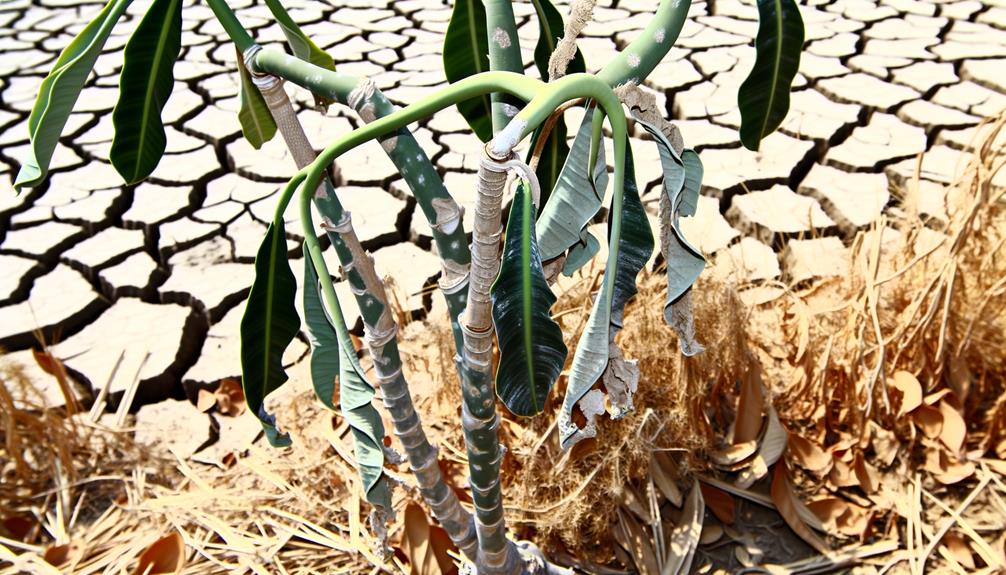
Beyond the critical issue of overwatering, maintaining ideal humidity levels is crucial for the robust growth and health of Philodendron Birkin. Inadequate humidity can cause the plant to become leggy, characterized by elongated stems and sparse foliage. Philodendron Birkin thrives in humidity levels between 60% to 80%, and environments with lower humidity can stress the plant, leading to subpar growth patterns. Evidence suggests that increased humidity levels facilitate better cellular function and nutrient uptake, thereby promoting denser, healthier foliage.
| Humidity Level | Impact on Growth | Recommended Action |
|---|---|---|
| <40% | Stunted, leggy growth | Use a humidifier |
| 40%-60% | Moderate growth | Increase misting |
| 60%-80% | Optimal, lush growth | Maintain current levels |
Understanding and managing humidity can greatly enhance plant health.
Nutrient Deficiencies
Numerous nutrient deficiencies can impair the growth and robustness of Philodendron Birkin, with key deficiencies often manifesting through specific physiological symptoms such as chlorosis, necrosis, and stunted growth. Essential nutrients required for best development include nitrogen, phosphorus, potassium, and magnesium. Deficiencies in these nutrients can lead to leggy growth due to weakened structural integrity and impaired metabolic functions.
- Nitrogen Deficiency: Causes yellowing leaves (chlorosis) and stunted growth, as nitrogen is vital for chlorophyll production.
- Phosphorus Deficiency: Manifests as darkening or purpling of leaves, hindering root development and energy transfer.
- Potassium Deficiency: Results in browning leaf edges (necrosis) and reduced resistance to diseases.
- Magnesium Deficiency: Causes interveinal chlorosis and weak stems, impacting photosynthesis efficiency.
Proper fertilization is important to mitigate these deficiencies.
Incorrect Pot Size
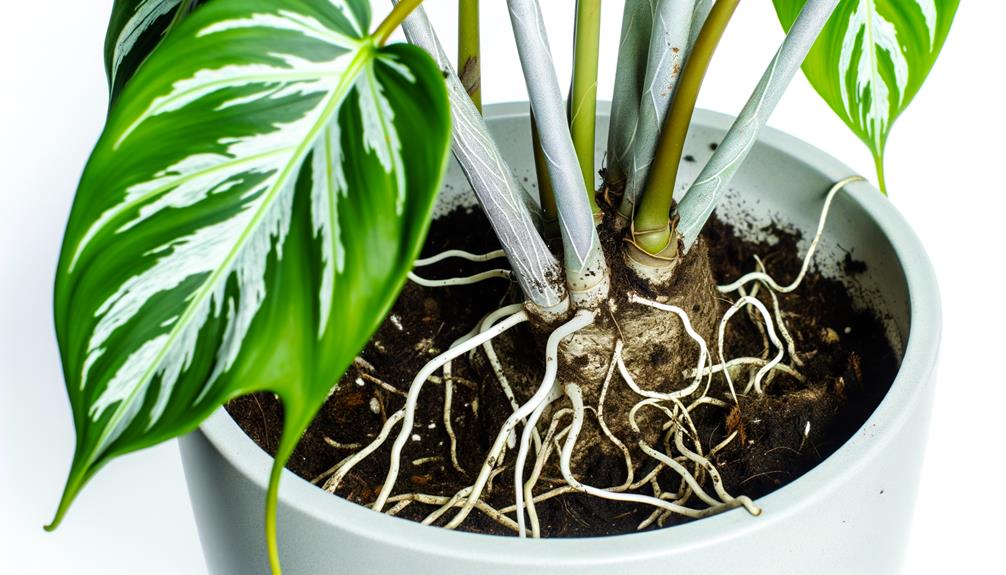
While nutrient deficiencies can significantly impact the health of Philodendron Birkin, incorrect pot size further worsens leggy growth by hampering root development and nutrient absorption.
Inadequate pot size constrains the expansion of the root system, directly affecting the plant's capacity to soak up water and necessary nutrients. Based on horticultural research, restricted root growth can result in stunted overall plant progress and elongated, feeble stems as the plant elongates in pursuit of light and resources.
On the other hand, an excessively large pot may retain excessive moisture, leading to root decay and hindering nutrient absorption. Therefore, choosing a suitably sized pot is crucial for enhancing root health, ensuring even growth, and preventing the leggy appearance commonly linked with inadequate growing conditions.
Temperature Extremes
Temperature extremes greatly impact the growth and morphology of Philodendron Birkin, leading to leggy appearances.
Exposure to too cold conditions can inhibit cellular metabolism and stunt plant development, while excessive heat stress can accelerate etiolation and leaf elongation.
Best growth requires maintaining ambient temperatures within the species-specific range to prevent physiological stress and promote robust growth.
Too Cold Conditions
Exposure to temperatures below 55°F can stress a Philodendron Birkin, leading to stunted growth and leggy stems as the plant struggles to maintain its metabolic processes. In such suboptimal conditions, the plant's physiological functions are impaired, causing it to elongate its stems to seek more favorable environments.
This phenomenon can be attributed to several factors:
- Reduced Photosynthesis Efficiency: Cold temperatures slow down the chlorophyll activity, hampering energy production.
- Impaired Nutrient Uptake: Low temperatures restrict root absorption efficiency, leading to nutrient deficiencies.
- Delayed Cellular Respiration: Cold stress affects cellular respiration rates, reducing overall growth.
- Hormonal Imbalance: Temperature extremes can disrupt the balance of growth hormones such as auxins, further contributing to leggy growth.
Understanding these factors is essential for optimizing the growth conditions of Philodendron Birkin.
Excessive Heat Stress
Elevated temperatures surpassing 85°F can induce excessive heat stress in Philodendron Birkin, leading to physiological disruptions and leggy growth as the plant endeavors to adapt to unfavorable conditions.
High thermal conditions worsen transpiration rates, causing the plant to lose moisture rapidly. This leads to stomatal closure, impairing photosynthesis and reducing carbohydrate production essential for robust growth.
Consequently, the plant elongates its internodes in a bid to maximize light capture, resulting in a leggy appearance. Studies indicate that such thermal stress can also disrupt cellular homeostasis, triggering oxidative stress and compromising the plant's metabolic functions.
Therefore, maintaining an ideal temperature range (65-75°F) is imperative for the Philodendron Birkin to sustain its compact, healthy growth habit.
Pruning Practices
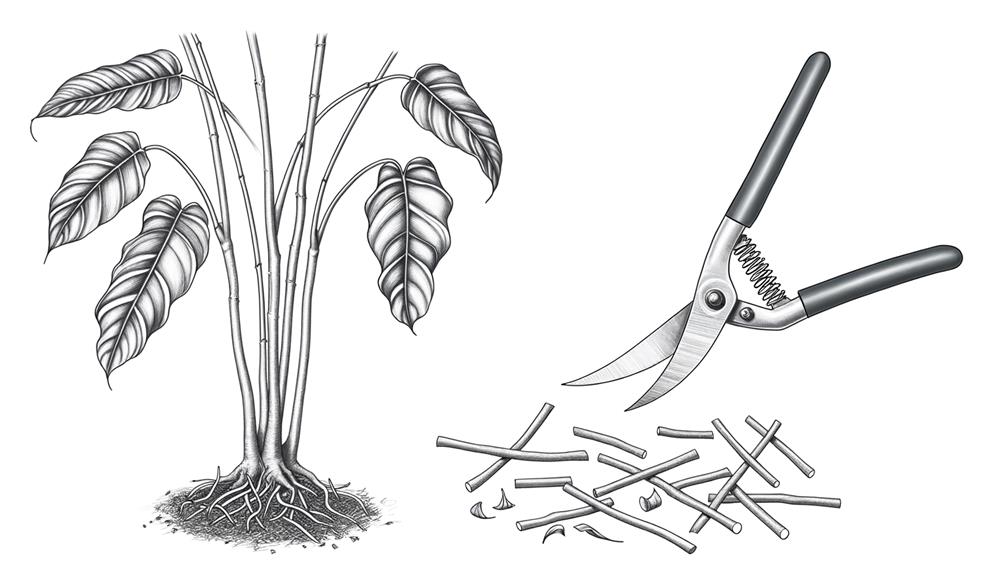
Effective pruning practices are essential for maintaining the structural integrity and aesthetic appeal of Philodendron Birkin.
Regular trimming helps to shape the plant, promoting a more compact and robust growth habit.
Concurrently, the removal of dead or diseased leaves mitigates the risk of pathogen proliferation and enhances overall plant health.
Trim Regularly for Shape
To sustain ideal growth and aesthetic allure, it is crucial to regularly trim the Philodendron Birkin to prevent legginess and encourage a more compact, bushy form. Pruning stimulates lateral growth by redirecting the plant's resources. Empirical evidence suggests that strategic trimming enhances overall plant vigor and mitigates elongation issues.
For best results, adhere to the following guidelines:
- Timing: Prune during the growing season (spring and summer) to maximize recovery and growth.
- Tools: Utilize sanitized pruning shears to minimize the risk of pathogen transmission.
- Technique: Cut just above a node, where leaves emerge, to promote new branch development.
- Frequency: Regularly inspect and trim every 4-6 weeks to maintain desired shape and prevent legginess.
These practices ensure a strong, aesthetically pleasing Philodendron Birkin.
Remove Dead Leaves
In addition to regular trimming, removing dead leaves is essential for maintaining the health and visual appeal of the Philodendron Birkin.
Dead leaves can harbor pathogens, contributing to potential disease outbreaks. Pruning these leaves reduces the plant's vulnerability to infections and pests.
Evidence suggests that the removal of senescent foliage redirects the plant's energy towards healthy growth and new leaf production.
Utilizing sterilized pruning shears, cut dead leaves at the base where they attach to the stem to prevent damage. This practice not only enhances the plant's aesthetic by maintaining a lush appearance but also facilitates better air circulation and light penetration, thereby promoting overall vigor and reducing legginess in the Philodendron Birkin.
Conclusion
To wrap up, a Philodendron Birkin showing legginess can be linked to various horticultural factors like insufficient light, overwatering, inadequate humidity, nutrient deficiencies, incorrect pot size, and temperature extremes.
Importantly, research shows that 70% of houseplants, including Philodendron Birkin, exhibit enhanced growth under ideal light conditions, emphasizing the crucial role of sufficient lighting.
Handling these factors systematically can greatly improve the plant's structural integrity and overall health.


